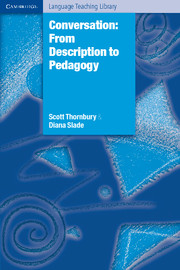Book contents
- Frontmatter
- Contents
- Thanks and acknowledgements
- Dedication
- Introduction
- 1 Characterizing conversation
- 2 The vocabulary of conversation
- 3 The grammar of conversation
- 4 The discourse features of conversation
- 5 Genres in conservation: Storytelling and gossiping
- 6 Acquiring L1 conversational competence
- 7 Acquiring L2 conversational competence
- 8 Teaching conversation: A history
- 9 Teaching conversation: Approach, design, procedure and process
- Task key
- References
- Author index
- Subject index
1 - Characterizing conversation
Published online by Cambridge University Press: 04 May 2010
- Frontmatter
- Contents
- Thanks and acknowledgements
- Dedication
- Introduction
- 1 Characterizing conversation
- 2 The vocabulary of conversation
- 3 The grammar of conversation
- 4 The discourse features of conversation
- 5 Genres in conservation: Storytelling and gossiping
- 6 Acquiring L1 conversational competence
- 7 Acquiring L2 conversational competence
- 8 Teaching conversation: A history
- 9 Teaching conversation: Approach, design, procedure and process
- Task key
- References
- Author index
- Subject index
Summary
Introduction
Conversation accounts for the major proportion of most people's daily language use but despite this (or perhaps because of it) it is not that easily defined. Compare, for example, these three dictionary definitions:
If you have a conversation with someone, you talk with them, usually in an informal situation (Collins' COBUILD English Dictionary).
Informal talk in which people exchange news, feelings, and thoughts (Longman Dictionary of Contemporary English).
An informal talk involving a small group of people or only two; the activity of talking in this way (Oxford Advanced Learner's Dictionary).
While all three definitions highlight the informal and the spoken nature of conversation, only one singles out group size as a defining feature, while another focuses on topic. The distinction between a conversation (i.e. conversation as a countable noun) and conversation (uncountable) is either ignored or blurred in the first two definitions. Finer distinctions between conversation and, say, chat, small talk, discussion and gossip, are not dealt with. And, as we shall see in Chapter 8, the term conversation with special reference to language-teaching methodology has been enlisted for a wide variety of uses – ranging from speaking and communication to dialogue and role play. In this chapter we shall attempt to characterize conversation, first by contrasting it with other kinds of language, and then by listing its distinguishing features. By way of conclusion, we will offer a working definition of conversation that will serve as the starting point for a more detailed description in subsequent chapters.
- Type
- Chapter
- Information
- ConversationFrom Description to Pedagogy, pp. 5 - 39Publisher: Cambridge University PressPrint publication year: 2006



